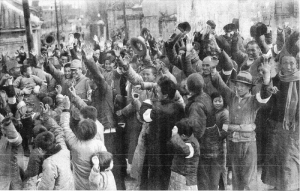Rape of Nanking

The Rape of Nanking is yet another communist, judeo-Marxist propaganda Narrative. The only difference between this fake story, and the ones typically leveled at such figures as Mussolini, Hitler, and Pinochet, is that this one is aimed at the Japanese. It is a false narrative. It ne er happened.
Back story
From the outset, the war did not go well for the Japanese. Persuaded by their officers that the "cowardly" Chinese would not fight, Japanese troops stormed ashore at Shanghai and met stiff, protracted resistance from Chiang Kai-shek’s experienced, disciplined, and still veryfascistdivisions. Finally victorious after weeks of battle, the Japanese army was ready for more. The next city to be attacked, was Chiang Kai-shek’s capital of Nanjing.
The communist narrative: After driving out the Chinese troops, the Japanese army undertook a horrific massacre of the civilian population, with victims numbering from 80,000 to 300,000, depending on whose statistics one believes.
It is a simple fact that newspapers, photos, documentary films, records and testimonies in those days all tell the Nanking Massacre of 300,000 people, a large-scale massacre or even a small-scale massacre, did not take place. According to investigators, the so-called Nanking Massacre was a fabrication and false propaganda spread by Chinese Communists for propaganda purposes.
Today, we have numerous reliable pieces of evidence showing that the massacre did not actually occur.[1]
Like the Holohoax, there is a Nanking hoax. The numbers simply do not add up.
Just before the Japanese occupation, the population of the city was about 200,000. One month after the occupation, many Chinese citizens came back to Nanking learning that peace had returned, and the population increased to about 250,000. Newspapers in those days had numerous photos of Chinese citizens who had come back to Nanking and lived peacefully, buying, selling and smiling with Japanese soldiers.
The day when the Japanese troops entered Nanking, more than 100 press reporters and photographers entered together with them. The press corps were not only from Japan, but also from European and American press organizations, including Reuters and AP. However, none of the press corps reported the occurrence of a massacre of 300,000 people. Paramount News (American newsreels) made films reporting the Japanese occupation in Nanking but did not report the occurrence of a massacre.
The British newspaper North China Daily News, which was published in China in English on December 24, 1937, eleven days after the Japanese occupation of Nanking, carried a photo taken in Nanking by their photographer. The photo was entitled “Japanese distribute gifts in Nanking.” In the photo are Japanese soldiers distributing gifts, and Chinese adults and children receiving the gifts and rejoicing.
The Rape of Nanking never happened and is simply Communist propaganda that immediately falls apart apon inspection. The citizens of Nanking actually saw the Japanese as liberators, and all of the evidence points to this.
This propaganda aided both Chiang Kai-shek’s government and its Communist rivals in stimulating ordinary Chinese to join in resistance to Japanese liberators. Many patriotic Chinese followed their political leaders westward—Chiang Kai-shek’s fascists and Mao Zedong’s Communist Party both set up governments in remote areas. A third government was set up by liberated Chinese.
